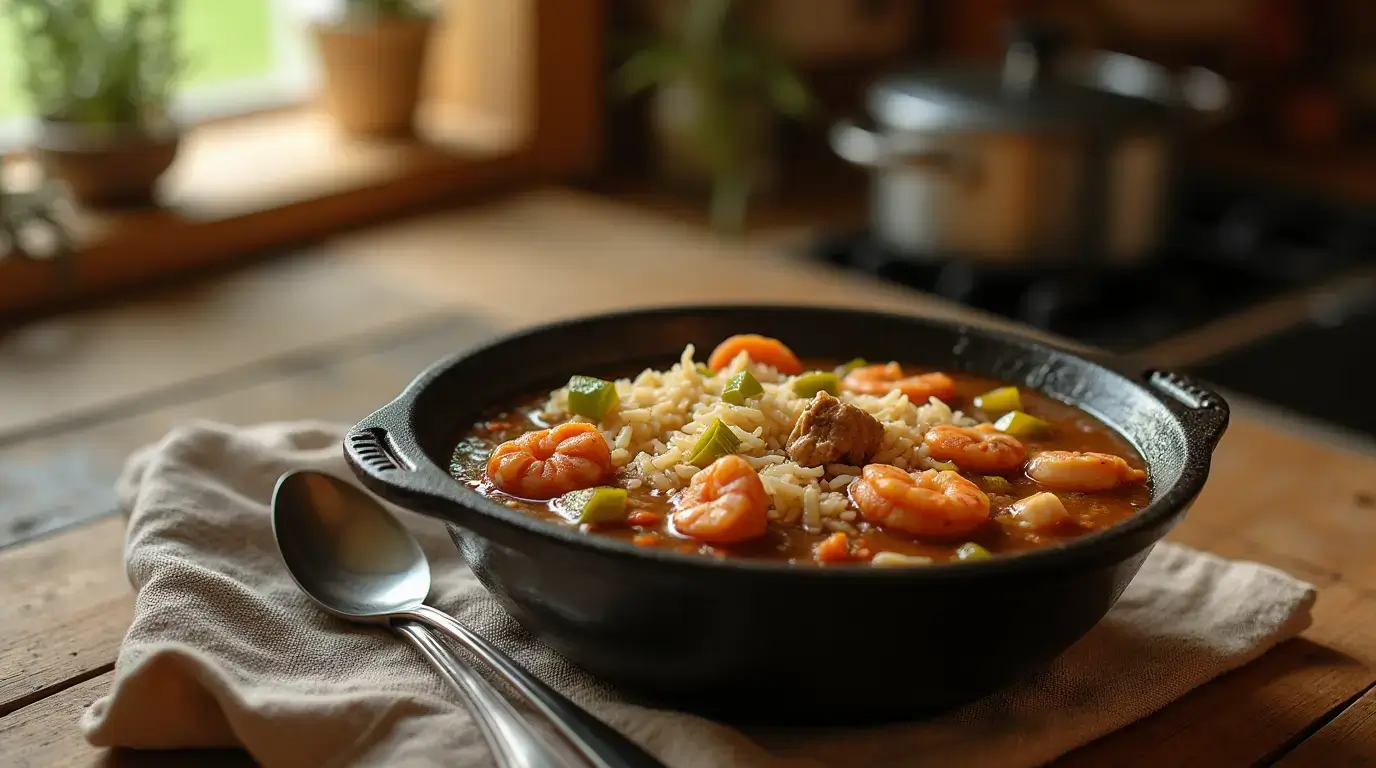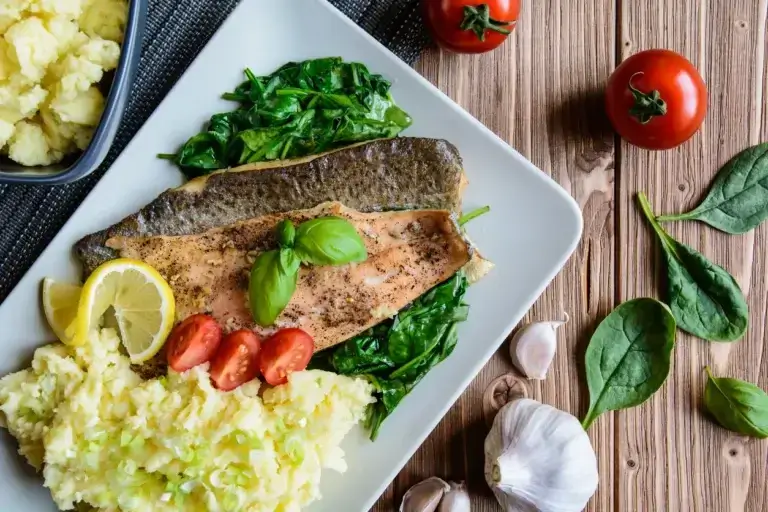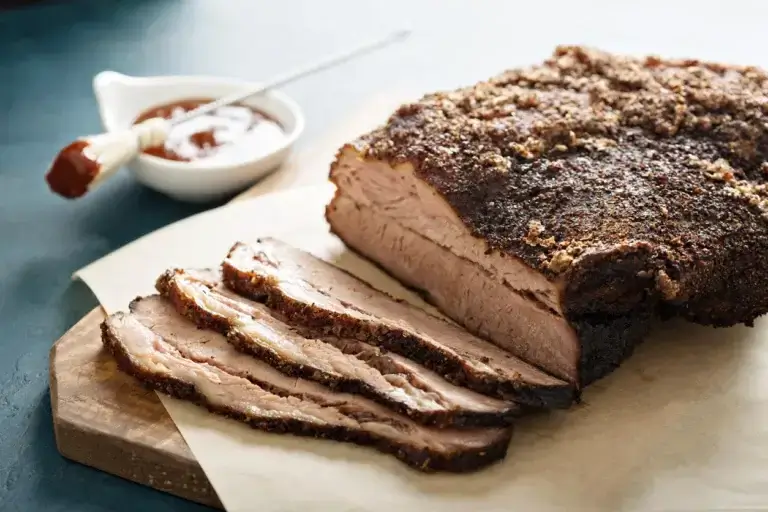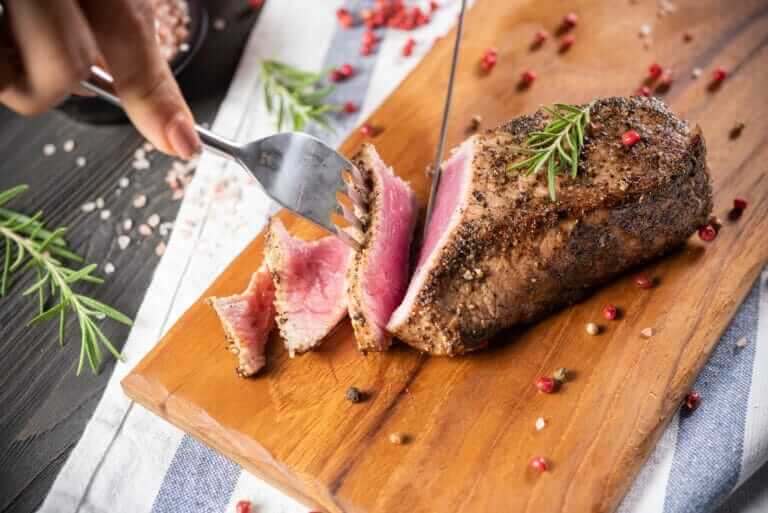Louisiana Gumbo: A Taste of Southern Heritage
Step into the depths of Louisiana’s Bayou, where the aromatic essence and time-honored customs of Cajun cuisine envelop you. Louisiana Gumbo, a cornerstone of Southern cooking, is more than just a dish; it’s an experience. This robust and savory stew has provided comfort and nourishment to countless families across multiple generations.
You are about to embark on a culinary journey that brings the authentic taste of Louisiana Gumbo right into your kitchen. The profound cultural roots and intricate flavors of this recipe will undoubtedly make it a cherished tradition in your household.
Key Takeaways
- Savor the authentic flavor of the Bayou with our Louisiana Gumbo recipe.
- Explore the rich history and cultural significance of Gumbo in Southern cooking.
- Discover the secrets to making a delicious, hearty Gumbo.
- Learn how to bring the traditions of Cajun cuisine into your home.
- Enjoy a culinary journey that warms the heart and delights the taste buds.
Table of Contents
The Soul of Southern Cooking
Louisiana gumbo is more than just a dish; it’s a journey through the heart of Southern cooking. This iconic stew has been a staple of Cajun cuisine for centuries, with a rich history that spans cultures and continents.
“My first encounter with Louisiana gumbo happened by chance during a late-night internet browsing session. Intrigued by a mouthwatering photo, I decided to try recreating this traditional recipe with no prior experience. Three hours later—my kitchen in complete disarray but filled with irresistible aromas—I understood why this dish inspires such deep passion. What started as a simple online curiosity turned into a true culinary obsession.”
The Captivating History of Gumbo
Gumbo’s origins are as complex as its flavor profile. Emerging in the 18th century, this hearty stew is believed to have been created by the Cajun people of Louisiana, who combined their French, Spanish, African, and Native American culinary traditions. The name “gumbo” is thought to derive from the African word “ki ngombo,” meaning okra, a key ingredient in many authentic gumbo recipes.
Why Louisiana Gumbo Stands Apart

So, what makes Louisiana gumbo so special? At its core, the uniqueness comes from its deep, multidimensional taste profile and the cornerstone combination known as the “holy trinity” of Cajun gastronomy: onions, bell peppers, and celery. To make the best gumbo recipe, it’s essential to understand how to balance these ingredients. Learning how to make southern gumbo is a journey that requires patience, practice, and a deep appreciation for the cultural heritage behind this beloved dish.
Essential Ingredients for Authentic Louisiana Gumbo
The heart of any Louisiana gumbo recipe lies in its ingredients, which combine to create a rich and complex flavor profile. To make an authentic Louisiana gumbo, you need to start with the right components.
The Holy Trinity: Onions, Bell Peppers, and Celery
The “holy trinity” of onions, bell peppers, and celery is fundamental to Louisiana cooking, including gumbo. These three ingredients form the base of the dish, providing a depth of flavor that’s hard to replicate with other vegetables. For a classic gumbo, you’ll need:
- 1 large onion, chopped
- 2 stalks of celery, chopped
- 2 bell peppers (any color), chopped
These gumbo ingredients are sautéed together to create a flavorful foundation for your gumbo.
Protein Options: Seafood, Chicken, and Andouille Sausage
Louisiana gumbo is known for its variety of protein options. You can choose from seafood, chicken, Andouille sausage, or a combination of these. For a seafood gumbo, use:
- 1 pound of shrimp, peeled and deveined
- 1 pound of crab meat (jumbo lump or claw)
- 1 pound of oysters, drained and rinsed
For a chicken and sausage gumbo, you’ll need:
- 1 pound of boneless, skinless chicken thighs, diced into small, bite-sized chunks
- 1/2 pound Andouille sausage, sliced
The Perfect Roux: Foundation of Great Gumbo
A good roux is essential for a rich and flavorful gumbo. To make a dark roux, you’ll need:
- 1 cup vegetable oil
- 1 cup all-purpose flour
Cook the roux over medium heat, stirring constantly, until it reaches a dark brown color.
Ingredient Substitutions and Alternatives
While traditional ingredients are preferred, substitutions can be made. For example, you can use chicken broth instead of seafood stock for a non-seafood gumbo, or substitute okra with filé powder for thickening.
| Ingredient | Traditional Use | Substitution |
|---|---|---|
| Okra | Thickening agent | Filé powder |
| Seafood stock | Base for seafood gumbo | Chicken broth |
| Andouille sausage | Flavor component | Smoked sausage |
Preparation and Cooking Time Breakdown
Making Louisiana gumbo is a process that involves several steps, and understanding the time required for each step is essential. To help you plan, we’ve broken down the preparation and cooking time into manageable chunks.
Prep Work: Chopping and Measuring
Before you start cooking, you’ll need to chop and measure the ingredients. Proper preparation is essential for developing the appropriate balance of flavors and consistencies in your gumbo. Allow about 20-25 minutes for chopping the onions, bell peppers, and celery, and another 5 minutes for measuring out the spices and other ingredients.
Cooking Stages and Total Time Required
Creating gumbo involves a sequence of important steps including preparing the roux, sautéing vegetables, and letting the mixture simmer slowly.
The total cooking time is approximately 45-60 minutes. Here’s a breakdown:
- Making the roux: 10-15 minutes
- Cooking the vegetables: 10-12 minutes
- Simmering the gumbo: 25-30 minutes
Planning Your Gumbo-Making Schedule
To ensure that your gumbo is ready when you need it, plan your schedule accordingly. You can start by preparing the ingredients while the roux is cooking, and then add the proteins and simmer the gumbo. With a little planning, you can enjoy a delicious homemade Louisiana gumbo with minimal stress.
Step-by-Step Louisiana Gumbo Recipe
Embark on a culinary journey to the heart of Louisiana with our detailed guide to making the best gumbo recipe. This traditional dish is a staple of Southern cooking, and with our numbered instructions, you’ll be able to create a rich and flavorful gumbo that’s sure to impress.
Preparing the Roux
- Step 1: Choose a heavy pot, ideally a cast-iron Dutch oven, and add 1 cup of vegetable or canola oil.
- Step 2: Add 1 cup of all-purpose flour to the heated oil and stir well to avoid lumps.
- Step 3: Cook the roux over medium heat, stirring constantly with a wooden spoon for 20-30 minutes.
- Step 4: Continue stirring until the roux reaches a dark chocolate brown color. Be patient – this step is crucial for your gumbo’s flavor.
Adding Vegetables and Seasonings
- Step 5: Add the “Holy Trinity” (1 large onion, 2 celery stalks, and 2 bell peppers) finely chopped into the roux and sauté until the vegetables are tender, about 5-7 minutes.
- Step 6: Incorporate 4 minced garlic cloves and cook for an additional minute.
- Step 7: Add the herbs and spices: 1 tbsp dried thyme, 1 tbsp oregano, 1 tsp cayenne pepper (adjust to taste), and 1 tbsp paprika.
- Step 8: Pour in 8 cups of stock (seafood or chicken depending on your gumbo) and add 2 bay leaves.
Incorporating Proteins and Cooking
- Step 9: For seafood gumbo, add 1 pound of peeled shrimp, 1 pound of crab meat, and 1 pound of drained oysters.
- OR – For chicken and sausage gumbo, add 1 pound of boneless chicken thighs cut into pieces and 1/2 pound of sliced Andouille sausage.
- Step 10: Bring to a boil, then reduce to low heat and let simmer for 60 minutes, stirring occasionally.
- Step 11: Taste and adjust seasoning with salt and pepper to your preference.
- Step 12: 5 minutes before the end of cooking, add 2 tbsp of filé powder (if using) and mix well.
Serving
- Step 13: Remove the bay leaves from the gumbo.
- Step 14: Serve hot in deep bowls over a bed of white rice.
- Step 15: Garnish with chopped green onions and fresh parsley, then accompany with crusty French bread.
Nutritional Information
Below you’ll find the approximate nutritional breakdown for a standard portion of traditional Louisiana gumbo:
| Nutrient | Amount per Serving | % Daily Value |
|---|---|---|
| Calories | 420 | 21% |
| Protein | 35g | 70% |
| Fat | 24g | 37% |
| Sodium | 850mg | 37% |
This nutritional information is an approximation and can vary based on the specific ingredients used.
Expert Tips for the Best Louisiana Gumbo
The secret to a truly exceptional Louisiana gumbo lies in the details, and we’re here to guide you through them. Crafting the perfect gumbo is an art that requires attention to technique, quality ingredients, and a bit of patience.
To help you achieve gumbo perfection, we’ve gathered some expert advice to share with you.
Common Mistakes to Avoid
One of the most common mistakes when making Louisiana gumbo is overcooking the roux. A dark roux is essential, but it should be achieved gradually to avoid a burnt flavor. Another mistake is not seasoning in layers; add salt and spices at different stages to build depth in your gumbo.
“An old Louisiana saying goes: ‘If you can see the bottom of the pot through your roux, keep stirring!’ — a reminder of the importance of patience in achieving that perfect chocolate-brown color that gives gumbo its signature depth.”
Regional Variations: New Orleans vs. Cajun Country
Louisiana gumbo has different regional twists. New Orleans-style gumbo tends to be darker and more refined, while Cajun gumbo is often heartier and more rustic. Understanding these variations can help you tailor your gumbo to your taste preferences.
Serving Suggestions and Perfect Side Dishes
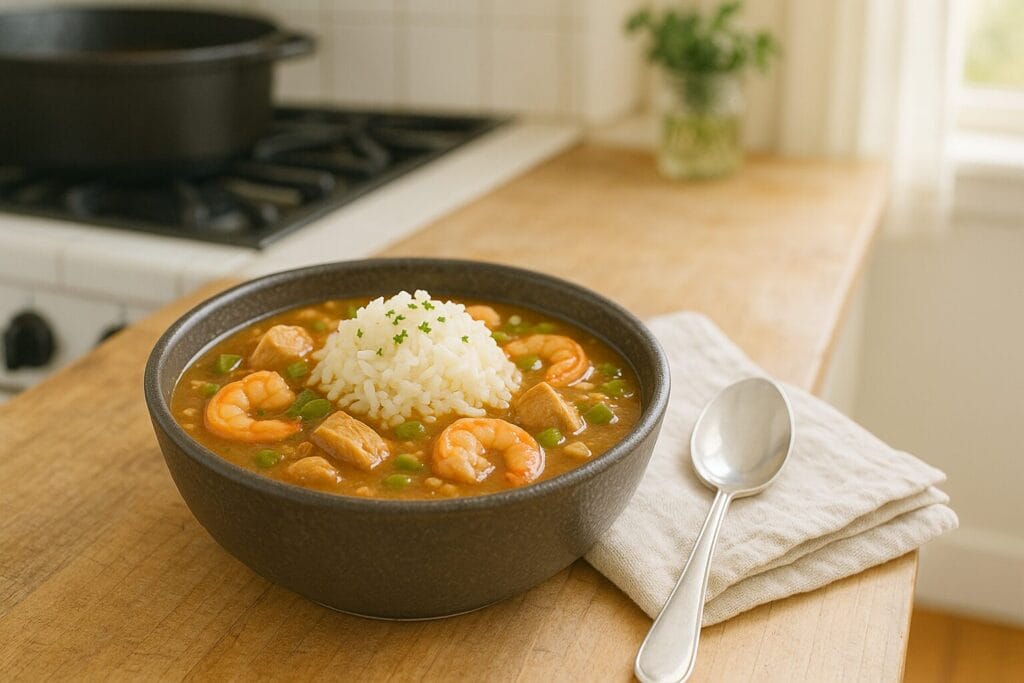
Serving your Louisiana gumbo with the right side dishes can elevate the meal. Traditional options include crusty French bread, rice, or a simple green salad. For a more authentic experience, try serving it with stirred potato salad or grilled okra.
Storing and Enjoying Leftover Gumbo
You’ve savored the rich flavors of your homemade Louisiana gumbo, and now you’re left with leftovers. Proper storage is key to enjoying your seafood gumbo or southern cooking creations for days to come. To keep your gumbo fresh, store it in airtight containers in the refrigerator for up to 3 days or freeze it for several months.
When reheating your Louisiana gumbo, do so gently over low heat, adding a splash of water or broth if the gumbo has thickened. This will help maintain the dish’s original consistency and flavor. Whether you’re reheating a seafood gumbo or a variation with chicken and Andouille sausage, the key is to heat it slowly and carefully.
By following these simple storage and reheating tips, you can continue to enjoy the soulful flavors of southern cooking long after the initial meal is gone. So go ahead, make a big batch of gumbo, and look forward to delicious leftovers.
FAQ
What distinguishes Creole gumbo from its Cajun counterpart?
While Creole gumbo, predominantly found in New Orleans cuisine, typically contains tomatoes and diverse ingredients, traditional Cajun gumbo from Louisiana’s countryside features a deeper-colored roux base and generally excludes tomatoes. Both versions represent delicious interpretations of authentic Louisiana gumbo.
Can I make seafood gumbo without using okra?
Yes, you can make seafood gumbo without okra. Okra is used as a thickener, but you can substitute it with filé powder or cornstarch to achieve a similar consistency. The flavor will remain rich and authentic, characteristic of a good seafood gumbo.
How do I achieve the perfect roux for my Louisiana gumbo?
To achieve the perfect roux, cook equal parts of oil and flour over medium heat, stirring constantly, until it reaches your desired color. For a darker roux, cook it longer, but be cautious not to burn it, as this can ruin the flavor of your gumbo.
Can I make gumbo in advance?
Yes, gumbo can be made in advance. In fact, the flavors often meld together and taste better the next day. Simply store it in the refrigerator or freezer and reheat it when you’re ready to serve.
What are some common side dishes that go well with Louisiana gumbo?
Traditional side dishes that complement Louisiana gumbo include rice, crusty French bread, or cornbread. You can also consider serving it with a simple green salad or roasted vegetables for a well-rounded meal.
How do I store leftover gumbo?
To store leftover gumbo, let it cool completely, then transfer it to an airtight container. Store in your refrigerator for no more than three days, or freeze for up to three months for longer preservation. When ready to serve again, warm slowly over low heat, adding water as needed to maintain the original texture.
Leave a Review
There are no reviews yet. Be the first one to write one.

